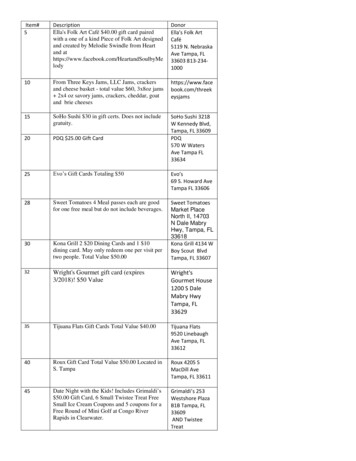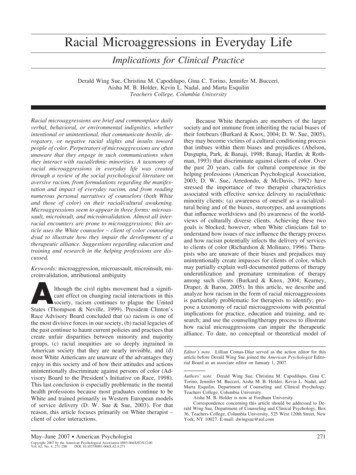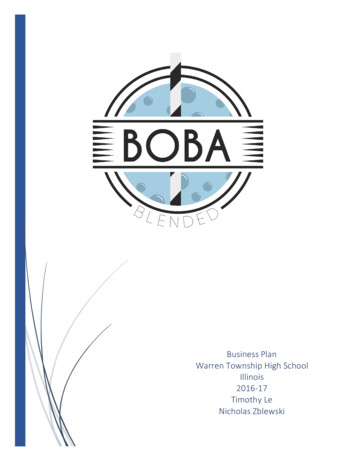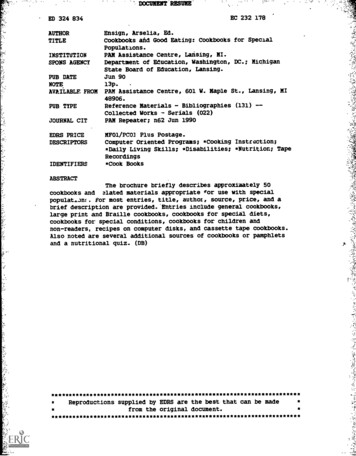
Transcription
Notable alumni include Anthony Bourdain,chef, author, and television personality;Anne Burrell, from Food Network’s Secretsof a Restaurant Chef; and Cat Cora, fromFood Network’s Iron Chef America.The Everyday Gourmet: Essential Secretsof Spices in Cooking was filmed on locationat the CIA’s campus at Greystone inCalifornia’s Napa Valley.A unique collaboration The Great Courses, leaders in lifelong learning “Pure intellectual stimulation that can be popped into the[audio or video] player anytime.”—Harvard Magazine “Passionate, erudite, living legend lecturers.Academia’s best lecturers are being captured on tape.”—The Los Angeles Times“A serious force in American education.”—The Wall Street Journalpartners with The Culinary Institute of America, leaders in culinary education “The CIA has been setting the standard for excellence in professionalculinary education for more than 60 years.”—Martha Stewart, entrepreneur and domestic lifestyle innovator “ [A]n institution that has truly changed the way the world looksat food.” —Anthony Terlato, chairman of Terlato Wine Groupand Wine Enthusiast’s Man of the Year in 2003“It’s the best culinary school in the world.”—Paul Bocuse, world-renowned French chefChef Bill Briwa is a Chef-Instructor at The Culinary Instituteof America at Greystone, where he has developed curriculaand has taught cooking, flavor dynamics, gastronomy, andfood-and-wine pairing for the past 15 years. A CertifiedExecutive Chef and Certified Hospitality Educator, ChefBriwa has worked extensively in the hospitality industryand has owned and operated his own bistro. The CulinaryInstitute of America is the world’s premier culinary college,setting the standard for excellence in professional culinaryeducation for more than six decades.THE GREAT COURSES Corporate Headquarters4840 Westfields Boulevard, Suite 500Chantilly, VA 20151-2299USAPhone: 1-800-832-2412www.thegreatcourses.comThe Everyday GourmetEssential Secrets of Spicesin CookingBill Briwa, Chef-InstructorThe Culinary Institute of AmericaFor thousands of years, spices made theirway along the Silk Road from the Far Eastto the Middle East and then by boat tonorthern Europe. Camel caravans broughtpepper, ginger, cinnamon, nutmeg, andmore to buyers willing to pay exorbitantprices for the flavor and even the magicalor medicinal powers of spices. Over time,spices came to distinguish the “flavorprofiles” of various regions of the world:India, with cumin, curry leaves, andtamarind; China, with ginger, sesameseeds, and star anise; and Mexico, withcanella, chiles, and garlic. In this course,you’ll tour these regions and others,exploring a variety of cooking traditionsand the flavors of cuisines from aroundthe world.In six lessons, you’ll learn techniques andflavor combinations that lead to deliciousmeals and discover strategies for seasoningto consistently achieve great results. Notonly will you encounter new spices and newdishes from a range of cultures, but you’llalso see ways to manipulate spices that canbe applied to the recipes you cook everyday. You’ll explore techniques for enhancingthe flavor of ingredients, such as wet or drytoasting, and learn to make distinctive andexotic spice blends. Along the way, you’llalso pick up some interesting tidbits ofculinary history, tips for storing andhandling spices, and even ideas forentertaining. Above all, this course willencourage you to experiment in thekitchen—to taste new flavors, try newingredients with confidence, and make thetime you spend cooking a richer and moresatisfying experience for both you andyour family.Look for our gourmet cooking, baking,and other Great Courses related to foodand wine at www.thegreatcourses.com.Cover Images: iStock/Thinkstock. Professor Photo: Justin Smith @JustinTimePhoto.com.Course No. 9222 2013 The Teaching Company.The Everyday Gourmet: Essential Secrets of Spices in CookingThe Everyday Gourmet: Essential Secretsof Spices in Cooking is taught by Chef BillBriwa, Certified Executive Chef, CertifiedHospitality Educator, and Chef-Instructor atThe Culinary Institute of America (CIA), theworld’s premier culinary college. Foundedin 1946 as a school to train returning WorldWar II veterans in the culinary arts, the CIAhas grown from its original enrollment of50 students and three faculty members toinclude more than 2,800 undergraduatestudents, more than 150 chefs andinstructors, and four campuses. In additionto its degree and certificate programs, thecollege also offers continuing educationprograms for foodservice professionals,wine professionals, and food enthusiasts;publishes textbooks and cookbooks;operates nine student-staffed restaurants;and hosts the Worlds of Flavor Conferenceand Festival.OI9222A
PUBLISHED BY:THE GREAT COURSESCorporate Headquarters4840 Westfields Boulevard, Suite 500Chantilly, Virginia 20151-2299Phone: 1-800-832-2412Fax: 703-378-3819www.thegreatcourses.comCopyright The Teaching Company, 2013Printed in the United States of AmericaThis book is in copyright. All rights reserved.Without limiting the rights under copyright reserved above,no part of this publication may be reproduced, stored inor introduced into a retrieval system, or transmitted,in any form, or by any means(electronic, mechanical, photocopying, recording, or otherwise),without the prior written permission ofThe Teaching Company.
Bill Briwa, C.E.C., C.H.E.Chef-InstructorThe Culinary Institute of Americaat GreystoneA1980 graduate of The Culinary Instituteof America (CIA), Chef Bill Briwa hasworked in the hospitality industry formore than 30 years and is a Certified ExecutiveChef and Certified Hospitality Educator. Inaddition to being the resident chef for The HessCollection winery in California’s Napa Valley,Chef Briwa owned and operated his own bistroand worked at Thomas Keller’s award-winningrestaurant The French Laundry. He was also the executive chef for The WineSpectator Restaurant at the CIA at Greystone and served as an officer on theboard of the St. Helena Farmers’ Market. As culinary chair of the 2004 NapaValley Wine Auction, Chef Briwa helped raise more than five million dollarsfor local charities. In addition to his work as a cook and chef, he has workedas both a baker and pastry chef. His writing on food and wine, olive oil, andcooking has been featured locally and in Fine Cooking, Mise en Place, andSunset, as well as in the trade publications Flavor & the Menu and PracticalWinery & Vineyard Journal.As a Chef-Instructor at the CIA, Chef Briwa has developed curricula and hastaught cooking, flavor dynamics, gastronomy, and food-and-wine pairing fulltime for the past 15 years. He has traveled to both teach and study cookingacross the United States; in China, Mexico, South and Central America, andEurope; and around the Mediterranean. In addition, he is partof the Industry Services Group at the CIA and works closelywith a broad range of corporate clients to help themrealize their culinary goals.Chef Briwa has been a speaker at manyprofessional conferences, and he takes partin the Healthy Kitchens, Healthy Livesconference held twice each year at theCIA at Greystone. The conference iscopresented by Harvard Schoolof Public Health and the CIA.Chef Briwa has collaboratedwith Dr. Connie Guttersen, aninstructor at the CIA and author of TheSonoma Diet, on numerous presentations oni
nutrition and cooking, including a course on the science of healthy cookingproduced by The Great Courses. In 2003, Chef Briwa was a judge for theAmerican Cheese Society, and in 2005, he presented on gastronomy at theannual conference of the International Association of Culinary Professionals.In 2005, 2006, and 2007, he presented at the International FoodserviceManufacturers Association’s Chain Operators Exchange conference, andin 2008 and 2009, he spoke at the National Restaurant Association Show.Chef Briwa also presented at Beyond Extra Virgin IV, a conference onsuperpremium olive oil, in Verona, Italy.Over the last 30 years of cooking and teaching, Chef Briwa has taken one shortbreak from the stove to become a puppeteer. He lives in Yountville, California,with his wife and a border collie—both of whom think highly of his cooking.Chef Briwa is the instructor for three other offerings in The Great Courses’Everyday Gourmet series: Rediscovering the Lost Art of Cooking, MakingHealthy Food Taste Great, and Making Great Meals in Less Time. ii
Table of ContentsLESSON GUIDESLesson 1India—Heart of the Spice World 3Lesson 2China—From Peppercorns to Tea 15Lesson 3Mexico—Chiles for Every Palate 25Lesson 4Mediterranean Spices—Exotic Blends 36Lesson 5Treasured Spices in Northern Europe 50Lesson 6New American Cuisine—The Global Kitchen 61SUPPLEMENTAL MATERIALRecipe List 68Glossary 69Bibliography 71Photographic Credits.73iii
Note to the Home ChefThe ingredient lists provided in this guidebook are for general referenceonly. Chef Briwa frequently substitutes or adds ingredients as he cooks andencourages you to do the same. The key to becoming a great chef is to learnabout your ingredients and how they change in the process of cooking, to tasteyour food frequently as you develop a dish, and to be courageous enough toexperiment in the kitchen.iv
The Everyday GourmetEssential Secrets of Spices in CookingAlthough we’re all members of the human family, as anyone who hastraveled knows, cultures around the world vary widely. Customs,traditions, and even foodstuffs are unique to particular regions orgroups of people. Just as each of us has individual traits that distinguish usfrom others, so, too, the food of each culture has a flavor profile that defines, insome ways, the people who eat it.In part, a flavor profile is shaped by climate and geography, both of which havean effect on the availability and taste of ingredients. It’s also shaped by history,tradition, and cooking techniques. And of course, what makes aflavor profile distinctive is how its culturechooses to embrace spices.In this six-lesson course, we willexplore a variety of cookingtraditions from around theworld, with the goal ofunderstanding those seductiveingredientscollectivelyknown as spices. We willidentifycookingtechniquesand flavor combinations that leadto delicious dishes and explore strategies forseasoning to consistently achieve great results. Along the way, I will sharetips on buying, storing, and working with a broad selection of spices and spiceblends, from star anise to za’atar.Throughout the course, we’ll focus on three overarching goals that will makeyou a better cook: Developing an understanding of the workings of taste and flavor Mastering basic cooking techniques Searching out high-quality ingredients and learning what you can expectof them1
The payoff for achieving these goals is cooking that is more enjoyable to othersand a richer and more personally satisfying experience in the kitchen for you.This course will broaden your horizons as it invites you to explore a worldof spices.Best regards,Bill Briwa, Chef-InstructorThe Culinary Institute of America2
India—Heart of the Spice WorldMLesson 1ost of the spices we consume come from the East—from India andthe Spice Islands beyond. India alone produces 50 percent of thespices that are consumed globally. From cumin to coriander, frompaprika to pepper, Indian cuisine is a cuisine of spice. If there are techniquesto be learned about working with spices, then India should be our teacher. Inthis lesson, we’ll make a complete Indian meal, including a basmati rice pilaf,sambar, shrimp with chile tamarind sauce, and chai tea. We’ll also learn tomake a masala—an Indian spice mixture—and two methods for toasting spicesthat yield interesting results.Basmati Rice PilafIngredientsYield: 6 portions 2 cups basmati rice 3 cups water ¼ cup ghee 2 cups thinly sliced 4 whole cloves 2 Tbs cardamomseeds 1½ tsp saltonions 2 sticks cinnamonAt the center of almost every Indian meal is rice. For our meal, we’ll makea rice pilaf using fragrant basmati rice. Begin by rinsing the rice in wateruntil the water runs clear—without any creamy white starch in it. Then, drainthe rice.Next, sweat the onions in ghee—clarified butter, which won’t burn. All themilk solids have been removed from this butter, and it typically has a fullerflavor. Ghee is the oil of choice for much of Indian cooking.3
When the onions are translucent, begin adding some whole spices:cardamom seeds, cinnamon sticks, and cloves. Because this rice willcook for about 20 minutes, thesespices have plenty of opportunityto slowly give up their flavor in aBasmati Riceliquid environment.Most of us don’t think of riceas a spice, yet the basmatirice used in India has awonderful fragrance—bothnutty and roasted.Even rawbasmatirice has aremarkablyfull aroma.Next, add the rice to the pan, stirringor tossing to ensure that each graingets a coat of the flavorful fat so thatit won’t stick to other grains.Basmati rice is a long-grain rice, aboutfive times as long as it is wide, andit usually cooks up fluffy and loose.Basmati is one of the few rices thatactually gets longer when it cooks,rather than wider.For every type of rice, there is aspecific ratio of rice to water forcooking. For basmati rice, the ratio is about 1.5:1 (water to rice). Pour thewater into the pan, give the rice one good stir, and then make sure to seasonthe water with salt before cooking. This step makes a significant differencein the finished product; always season the liquid before cooking the rice. Ifyou don’t know how much salt to add, taste the liquid; it should taste likewell-seasoned broth.Turn the heat up to bring the rice to a boil. When it reaches a boil, reducethe heat until it’s barely at a simmer—just a few bubbles breaking thesurface. Cover the pan with atight-fitting lid and cook therice gently for 20 minutes.Curry PowderWatch the steam that escapesCurry powder is a familiar spicefrom under the lid. If you seemixture to us, but if you go to India,too much steam, turn the heatyou won’t find it. Indian cooksdown a bit. At the end of themake their mixtures as they need20 minutes, pull the pan offthem, and the one used for fishthe heat and let the rice sitfor 5 or 10 minutes. Rice isand vegetables may bevery delicate just after it hasdifferent than thefinished cooking; resting for aone used forfew minutes allows it to firmmeats.up slightly.4
5
Sambar MasalaIngredientsYield: 1 cup ½ cup corianderseeds 12–14 whole dryred chile pods 1 ½ tsp cuminseeds 1 ½ tsp white splitgram beans(urad dal) 1 ½ tsp yellowmung beans(moong dal) 1 ½ tsp black 1 ½ tsp yellow split 1 ½ tsp fenugreek 2 Tbs turmericpeppercornspeas (chana dal)seedsIf rice is at the center of the table in an Indian meal, close beside it, you’ll findsomething called dal—a cross between a stew and a soup that’s made primarilywith lentils. The dal known as sambar comes from the southern part of India.It starts out with a spice mixture called a masala.The first step in creating a sambar dal is to make the sambar powder. Begin bytoasting whole spices—coriander, cumin, peppercorns, and fenugreek—in adry pan to draw out their flavor. As the pan starts to heat up, make sure to keepthe spices moving so they don’t burn. You’ll know the pan is getting hot whenthe spices start to become aromatic. Next, you’ll notice some popping; theseeds pop just the way popcorn does in a hot pan. Then, you’ll notice that thecolor slowly begins to darken. Finally, you’ll see a little bit of smoke comingoff the pan. Keep tossing or stirring the spices throughout these changes;otherwise, they will burn. When the spices are toasted, remove them from thepan to a cool plate.The next step is to toast the various dals. We’re using three different kinds:moong dal, which is mung beans that have had the outside layer ground off andare then split; urad dal, another kind of lentil that has had the outside groundoff and has been split; and chana dal, which is a small garbanzo that has beensplit. In India, these dals are considered not just lentils but also spices; we’lltoast them to bring out their rich, nutty flavor.6
When you first add the dals to the pan, they look fairly bright—without muchcolor. Toast them until they start to take on a golden hue, using the white uraddal as a marker for browning. Again, keep the dals moving as you toast them.Once the spices and dals are toasted, grind them in a spice mill (or with amortar and pestle) to make sambar powder. You can also add some dried chilesto enhance the heat. One of the nice things about making this powder yourselfis that you can choose to add more or fewer chiles. If you are particularlysensitive to spicy food, you might not be able to use commercial sambarpowder (available at Indian grocery stores), but if you make it yourself, youcan adjust the heat to your liking.Sambar is a dal from southern India, where the weather is very hot; as many ofus know, eating spicy food is one trick for staying cool in a hot environment. Atrick for moderating the heat of chiles is to break them in half and remove theseeds and ribs. This technique eliminates 80 percent or more of the chiles’ heat.Finally, to the ground-up ingredients, add turmeric, which has a wonderfulcitrusy flavor and a distinctive color. Because it is a ground spice and wouldburn easily, it isn’t toasted.7
SambarIngredientsYield: 6 portions 4 cups water 1 cup moong dal(or masoor dal) 2 tomatoes, concassé 2–3 zucchini, slicedlengthwise 2 carrots, cut in large chunks 2 potatoes, cut in largechunks 1 Tbs turmeric 2 tsp salt 2 tsp tamarind paste or 1 1 Tbs coriander seed,toasted and ground 1 tsp cumin seed, toastedand ground 1 Tbs black mustard seed,toasted 1–2 jalapeños, seeded andchopped 6–8 dried curry leaves,toasted 1 Tbs sambarmasalaTbs fresh lemon juice 1 Tbs vegetable oil or gheeFor the dal known as sambar in southern India, begin by putting the moongdal into water and cooking it into a puree. This step should take about 20 or30 minutes. Because the outside layer has been ground off and the beans havebeen split, they tend to fall apart and create a puree easily. You’re looking for atexture that’s a cross between a soup and a stew.To the moong dal, add the tomato concassé and turmeric and allow them tocook together. After about 20 minutes, take a taste. You might be surprised tofind that all on its own, the turmeric is a bit bitter. But both salt and acid cancounter bitterness. When you add the sambar powder to finish the dish, you’llfind that its flavors are so large that bitterness stops being the star and becomesone of the supporting players of a more compelling mix of flavors.At this point, add the carrots, zucchini, and potatoes, and cook for another 20minutes, until the vegetables are tender. You want the potatoes to fall apart alittle bit and thicken the mixture. If at any point the sambar seems dry, add alittle more liquid.8
In a separate pan, we’ll toast some additional spices: mustard seed, corianderseed, cumin seed, and curry leaves. But instead of using a dry pan, the ideahere is to pop these spices like popcorn in a little bit of oil. Begin by heatingsome ghee, then add the mustard, coriander, and cumin seeds. Make sure youhave a lid close by because when the mustard seeds heat up, they’ll pop out ofthe pan. Leave the pan uncovered until you hear the first couple of pops. Then,put the lid on and keep swirling the pan as though you were making popcorn.Periodically, stop and listen to what’s happening in the pan.For a textural element, sizzle some curry leaves in the hot ghee. Then, pour theoil with the spices in it directly into the sambar. This step completely changesthe flavor profile of the dish, and because the spices were freshly popped, theflavor is still vital. Taste again and add a little salt and a squeeze of lemonjuice or some tamarind paste. Of course, also add the sambar powder we madeearlier. Serve the sambar with additional powder and basmati rice pilaf.9
Shrimp with Chile Tamarind SauceIngredientsYield: 6 portionsShrimp and sauce: 1 ½ lb medium or largeshrimp, peeled and deveined ¼ tsp cayenne ¼ tsp turmeric 1 ¼ tsp salt 5 Tbs vegetable oil ½ tsp tamarind paste ½ tsp mustard seeds ⅛ tsp fenugreek seeds 10–12 fresh curry leaves 2 cups onions, thinly sliced 1 ½ tsp garlic, minced 1 ½ tsp ginger, minced 1 tsp fresh green chile(serrano or Thai), minced ¾ cup tomatoes, choppedMasala: 3 tsp coriander ¾ tsp cayenne ½ tsp cuminShrimp with chile tamarind sauce will go along with our rice and sambar.Begin by mixing cayenne, turmeric, and salt together in a bowl, then addingsome shrimp and coating it with the spices. The mixture of spices flavors theshrimp—in effect, marinates them—and acts as a preservative. In a culture thatdoesn’t always have ready access to refrigeration, adding shrimp to a spicemixture like this one will guarantee that it stays fresh.The next step is to create a masala. In an Indian kitchen, the cook might pull outa masala dabba, or spice caddy, and mix together some cayenne, coriander,and cumin. We’ll use the same three spices for our masala, and we’ll adjust theflavor of the finished dish by adding more of that masala at the end, just as wedid when we made the sambar. To complete your mise en place, have on handsome tamarind paste.In a large pan, heat some oil and pop the mustard seeds, keeping a lid closeby, just as we did earlier. Next, add some fenugreek seeds and curry leaves.When the curry leaves stop sizzling, add sliced onions and cook until they aretranslucent and starting to brown along the edges. Next, add garlic, ginger, andhot chiles, but go light on the chiles because there is already some cayenne inthis dish. Once the garlic is aromatic, add the tomatoes; you may need to lowerthe heat at this point to prevent the garlic from burning. This mixture, alongwith the tamarind paste, will be the sauce. Toward the end of cooking, you may10
need to turn up the heat to reducethe sauce.While the sauce cooks, sauté theshrimp in oil, allowing the spiceson the outside of the shrimpto touch the hot surface of thepan. Heat the oil in the pan firstand watch for it to smoke. Thesmoke is an indication of the fatbeginning to break down; whenit smokes, you should eithertake the pan off the heat or addfood. Essentially, the smoke istelling you that the oil can’tget any hotter.TamarindTamarind is a souring agent. It isthe fruit of the tamarind tree andgrows in the shape of a long pod—about as long as a banana—but flatand brown. On the outside is a hardshell, which is cracked off, and theinside is a sweet-sour paste shotthrough with fibers and seeds. Theway to get the fibers and seeds outis to break up the block and soak itin hot water—overnight if possible.What’s left is tamarind liquid andpaste. It’s very sour but also hassome sweetness and fruitiness to itand makes a delicious condiment.Shrimp cooks in as little as 5minutes. Once it changes colorand firms up, you know it’s almostdone. At that point, add the sauce to the shrimp and finish cooking the twotogether. This step allows the fond—foundational flavors that are clinging tothe pan—to make their way into the sauce. You can turn off the heat becausethe shrimp will continue to cook in the residual heat of the pan.11
Finally, add the masala we made earlier. Because you’re adding it right at theend, it will lend a wonderful vibrancy to the flavor and aroma of the dish. Don’tadd all of the masala; put some on the table to allow your guests to adjust theseasoning for themselves.Chai TeaIngredientsYield: 3 portions 1 cinnamon stick 6 black peppercorns 4 whole cloves 2 cardamom pods 4 cups water 1 cup milk 2 Tbs loose black tea ½ cup sugaror to tasteTo complete our Indian meal, grind up some cinnamon, cardamom, cloves,and black peppercorns using a mortar and pestle. Make sure to break the seedsopen and create a wide surface area. Once the spices are ground, put them in apot with 4 cups of water and about ½ cup of sugar. Bring the mixture to a boiland let it steep for 5 to 10 minutes. Next, add 1 cup of milk and a little bit ofblack tea, bring the mixture back to a boil, and steep for 3 to 5 minutes. Strainthe spices out and enjoy your soothing chai tea.Important Termsconcassé: Method of peeling, seeding, and roughly chopping tomatoes.dal: Dried beans or lentils, such as moong dal, urad dal, and chana dal. Also adish made primarily with lentils that is a cross between a stew and a soup.fenugreek: An herb of the pea family that has aromatic seeds.fond: Culinary term referring to foundational flavors.ghee: Clarified butter used in India.masala: Indian spice mixture.12
13
masala dabba: Indian spice caddy.mise en place: French term meaning “set in place” or “everything in place”;in professional kitchens, the term refers to organized and prepped ingredients,ready to be used in a dish.sambar: A type of dal served in southern India.Essential Herbs and Spicesof IndiaCapersCardamomCinnamonClovesCurry LeavesFennelFenugreek14TamarindTurmeric
China—From Peppercorns to TeaCLesson 2hina is, obviously, a huge country and has many different kinds offood. In Canton and other southern regions, the food tends to be a bitmilder. But when you make your way north, the weather gets colder,and the food gets heavier and more complex. Two areas in particular, Hunanand Sichuan, are ground zero for spicy food. In this lesson, we’ll make somespicy condiments and dishes and learn Asian techniques for braising andsmoking meat. As we’ll see, the spices used may change from one country oreven one region to another, but the techniques for manipulating spice can beapplied universally.Five-Spice OilIngredientsYield: 2 cups 1 ⅓ cups corn or peanut oil ½ Tbs sesame oil 3 large scallions, cut in thick 2 tsp brown Sichuan(Szechuan) peppercorns Zest of 1 orangerings (green and white parts) 10 quarter-sized “coins” ofginger, smashed 1 ½ tsp dried red pepperflakesLet’s begin by making a condiment that is a nice variation on chile oil: fivespice oil. Start by heating up neutral vegetable oil, then add the “coins” ofginger, Sichuan peppercorns, red pepper flakes, and scallions. Heat the oilmixture very gently. If it sizzles, it’s almost too hot. The temperature should bearound 160 —less than a boil at 212 . Once the oil reaches that temperature,turn the heat down and let the mixture steep for about 10 minutes.15
After 10 minutes, take the oiloff the heat and add sesame oiland orange zest. Allow the oilto cool and steep, overnight ifpossible. The next day, strainout all the solids. Transfer theoil to a jar or bottle; it will keepnicely in the refrigerator oreven on the pantry shelf for twoor three months.Sichuan PeppercornsIn a handful of Sichuanpeppercorns, you may notice somesmall black seeds mixed in with thereddish husk. If you get a batch ofSichuan peppercorns that have toomany black seeds, it’s worth thetime and effort to separate the two.The seeds tend to be hard and don’thave as much flavor as the outsideof the peppercorn.When you taste the oil, youmight be surprised at howmild it is, especially if you’veever tasted a raw Sichuanpeppercorn, which can numbthe inside of your mouth. As theoil sits on your palate, you’ll notice the orange and the spice from the ginger. Thenumbing, electric quality of the peppercorn is still present, but it’s subtle. You’llalso notice the burn of the pepper flakes in your throat. This five-spice oil is acomplex condiment.Sichuan Pepper-SaltAnother condiment we can make with Sichuan peppercorns is Sichuan peppersalt. Cook twice as much salt as Sichuan peppercorns together in a dry pan.The salt will take a bit of time to heat up, but after a while, you will notice thearoma of the peppercorns and the salt will turn a bit dark. When it does, takeit off the heat and keep it moving for 3 or 4 minutes; the hot salt will continuecooking. After a few minutes, the salt will start to turn gray; this change meansthat the spices are starting to toast. You may also see a little smoke coming offSichuan pepper-salt is a spicy alternative to common table salt; store in a cool,dry place in a sealed container, and it will last for months.16
the pan. Remember to keep the pan moving. Toasting extracts the essential oilsfrom the Sichuan peppercorns and mixes them with the salt. When the spiceshave cooled, grind them in a spice grinder.The Five HeapsIngredientsYield: 2–3 main-course portions or 4–6 side-dish portions ½ lb fresh or frozen HongKong noodles (long and thin)Dressing: 2 Tbs toasted sesame seeds 2 Tbs five-spice oil(see above) 2 Tbs Chinese sesamepaste or peanut butter 2 Tbs water 1 Tbs soy sauce 2 tsp unseasoned Chineseor Japanese rice vinegar 1 ½ tsp sugar Scant ¼ tsp roasted Sichuanpepper-salt ¼–½ tsp chile oil (optional)Five heaps: 1 cup crisp green vegetable(choose one): slivered freshsnow peas or sugar snappeas, slivered string beansor Chinese long beans cutinto 2-inch lengths, sliveredcelery hearts and innerribs cut into 2-inch lengths,slivered seedless cucumber 1 cup carrots, juliennedor shredded 1 cup radishes, shredded 1 cup Black Forest ham,slivered, or cookedchicken, shreddedGarnish: Fresh coriander,coarsely choppe
The Culinary Institute of America (CIA), the world’s premier culinary college. Founded in 1946 as a school to train returning World War II veterans in the culinary arts, the CIA has grown from its original enrollment of 50 students and three faculty members to include more t










